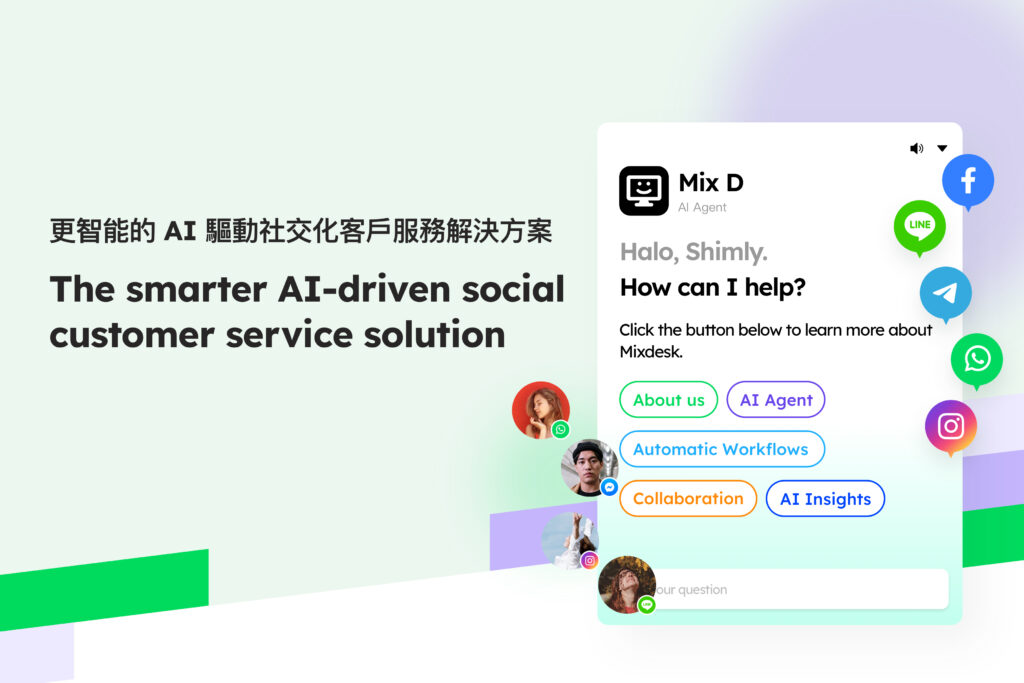Author of this article:Fiona
In 2025, when global competition is heating up,,The rules of the game for cross-border e-commerce have been completely rewritten by AI technology。 When traditional foreign trade companies are still relying on manual product selection, manual translation, and lagging logistics tracking, leading players have already realized the full-link intelligence of ”product selection-marketing-service-supply chain” through AI tools. In order to stand out, companies must continuously innovate and optimize their operating models, especially in key areas such as customer service, data analysis, and sales management. The application of AI technology has provided unprecedented opportunities for cross-border e-commerce enterprises, which can not only improve operational efficiency, but also greatly improve the customer experience, thereby promoting the long-term growth of enterprises.
This article will discuss the necessary AI tools for cross-border e-commerce companies in 2025, provide selection guidelines and practical cases, and help you build a global competitive advantage in the AI wave.
- 1. The AI tool Revolution of Cross-border e-commerce: from efficiency tools to growth engines
- 2. Multi-modal content generation AI tools: the creative engine of Global marketing
- 3. The three core contradictions and challenges of Cross-border e-commerce customer service
- 4. Omni-channel intelligent customer service AI helps enterprises
- 5. Mixdesk: A leader in AI Tools for Cross-border e-commerce
- 1. Multi-modal interactive technical support to break down communication barriers
- 2. Intelligent customer service: 24/7 service to global customers
- 3. Data analysis and insight to help accurate decision-making
- 4. Personalized marketing and recommendation system to increase conversion rate
- 5. Improve customer experience and increase customer loyalty
- Conclusion
1. The AI tool Revolution of Cross-border e-commerce: from efficiency tools to growth engines
The essence of cross-border e-commerce is to solve the two core problems of ”information asymmetry” and ”experience localization” in the global market. Under the traditional model, companies often fall into the dilemma of ”three high and one low”: the cost of trial and error in product selection is high, the threshold for multi-language operation is high, the compliance risk is high, and the conversion efficiency is low. The application of AI technology is fundamentally solving these problems and promoting cross-border operations from ”experience-driven” to ”data-driven” refined management.
- Intelligent transition of product selection decision-makingIt has completely changed the starting logic of cross-border e-commerce. The model that relied on procurement experience and lagging sales data in the past has been replaced by real-time data analysis and trend forecasting.AI selection toolIt can integrate real-time data from 10+ platforms such as Amazon and Shopee, and identify potential explosive characteristics through machine learning, so that the selection of products can change from ”betting on luck” to ”calculating probability”.

- Industrial production of marketing contentBroke down the language and cultural barriers to cross-border communication. The maturity of generative AI has significantly reduced the cost of multilingual content creation. At the same time, AI can deeply adapt to the cultural preferences of different markets, and adjust promotional expressions according to different target markets to avoid cultural taboos.Localization abilityIt is beyond the reach of traditional translation tools.
- Customer service experience reconstructionBrand trust is being reshaped. Traditional customer service systems are difficult to achieve a consistent experience across platforms, and AI customer service solutions passOmni-channel integrationAnd intelligent response, the average response time will be greatly shortened.MixdeskAdvanced tools such as AI have realized seamless integration with ERP and logistics systems, and customers can directly query logistics status and return and exchange policies through AI without manual intervention.
- Intelligent logistics managementEscort global operations. 30% of delays in cross-border logistics are due to information asymmetry, and the AI prediction system can analyze customs data, weather conditions and transportation history to warn of potential risks in advance and improve operational efficiency.
The underlying logic of these changes is the comprehensive reconstruction of the ”people and goods yard” of cross-border e-commerce by AI technology: understand the needs of ”people” through user portraits, optimize the circulation of ”goods” through data modeling, and improve the experience of ”people” through intelligent interaction.The competition in 2025 is no longer a competition for a single tool, But a contest of AI application density and depth.
2. Multi-modal content generation AI tools: the creative engine of Global marketing
The core challenge of cross-border marketing is to deliver consistent brand value in different cultural contexts. Generative AI solves this problem through multi-modal content production capacity. In 2025, mainstream AI tools have realized the full-format content generation of ”text-image-video-voice”, supporting accurate conversion in 100+ languages, reducing the production cost of marketing content and increasing the iteration speed.

- Text generationaspect,ChatGPT(GPT-4) With the ecological advantages of 400 million weekly active users, it has become the preferred tool for multilingual Listing optimization. It can adjust the expression of product selling points according to the consumption habits of the target market: it emphasizes technical parameters for the German market, highlights cost performance for the Southeast Asian market, and avoids sensitive expressions for the Middle East market.
- Visual content creationfield,Google Gemini 2.5Its multi-modal capabilities are unique, it can analyze popular visual elements of Instagram, TikTok and other platforms, and generate product pictures and short video scripts that meet the local aesthetic. Even more revolutionary are AI video generation tools. Midjourney, Stable Difusssiondeng, etc. support speech synthesis and intelligent picture generation in different languages. Multilingual product videos produced with these tools can help companies significantly improve their average conversion rate.
The high-level gameplay of content operation is a combination of ”globalization strategy + localized execution". AI tools can automatically generate the basic content framework, and then the local team can supplement the cultural details. This human-computer collaboration model not only ensures efficiency but also ensures accuracy.
3. The three core contradictions and challenges of Cross-border e-commerce customer service
In the cross-border e-commerce industry, customer service has always been a core challenge. The customer service scenario of cross-border e-commerce is far more complicated than that of local business. Its essence is to establish a standardized trust system in different cultures, regulations and technical environments. In 2025, this complexity will further intensify with the fragmentation of the global market, forming three core contradictions that need to be resolved urgently.
- The contradiction between the fragmentation of omni-channel experience and the scarcity of customer patienceIt is becoming the main culprit of the loss of satisfaction. Consumers will complete a single shopping journey through multiple channels-from browsing products on Facebook, consulting details on WhatsApp, to placing orders on independent stations, tracking logistics by email, and finally sharing their experience on Instagram. However, traditional customer service systems often fight for each other: the questions that customers have asked on Facebook must be redescribed when they go to WhatsApp for consultation; the order information that customer service sees on independent stations cannot be retrieved in the email reply. This kind of out-of-sync channel information leads to repeated inquiries by customers, which directly leads to a decrease in customer satisfaction and customer service efficiency. What's more serious is that in a market dominated by Generation Z consumers,,More than half of customers will completely abandon the brand due to a bad service experience, And the cost of acquiring new customers is more than 5 times that of retaining old customers.
- The deep dilemma of language barriers and cultural AdaptationIt's far beyond a simple translation problem. What is more fatal than language errors is cultural misreading. The limitation of traditional translation tools is that they can only solve ”language conversion”, but they cannot convey the cultural code in the context. In 2025, as small language markets (such as Vietnam, Turkey, and Poland) become new engines of growth, this kind of cultural adaptability has becomeCustomer service toolsThe necessary qualities.
- The problem of balancing compliance and service experienceReach new heights in 2025. Five years after the implementation of the GDPR, more than 130 countries and regions around the world have introduced similar data privacy regulations. From the European Union's GDPR to Brazil's LGPD and Thailand's PDPA, compliance requirements are showing a dual trend of ”regionalization” and ”strictness”. However, excessive emphasis on compliance can also lead to a regression in the service experience: cumbersome authorization processes, restricted data analysis, and rigid response templates make what should have been a personalized service become a standardized response. How to find a balance between ”data availability” and ”privacy protection" has become a compulsory course for cross-border e-commerce customer service.
The essence of these challenges is that the traditional customer service model cannot cope with the complexity of global operations. When companies try to cover more languages and channels by increasing manual customer service, costs will grow exponentially; relying solely on mechanical automatic replies will sacrifice the customer experience. The solution in 2025 must be technology-driven "large-scale personalization”-it can not only understand the cultural context and customer emotions like a senior customer service, but also have the unique efficiency and consistency of the machine.
The emergence of AI customer service system has solved this series of problems. AI customer service can not only respond quickly to customer inquiries, but also provide personalized services. Through natural language processing (NLP) technology, AI can understand customer needs and give accurate answers. Whether it is basic order inquiries or complex after-sales issues, AI customer service can handle them efficiently and provide a unified customer service experience.
4. Omni-channel intelligent customer service AI helps enterprises
1. Experience innovation across language and time difference
Customer service is the moat of cross-border e-commerce, and AI customer service tools pass”7×24 hours response + personalized interaction“The ability to raise satisfaction to a new level. In 2025, intelligent customer service has surpassed the simple question-and-answer function and evolved into a full-process assistant of ”consultation-conversion-repurchase”.
MixdeskAs a benchmark solution for cross-border customer service, it has realized in-depth access to ERP and logistics systems, and created an ”AI employee” service model. Customers can directly query package dynamics, return and exchange policies, and even personalized recommendations through AI, and the system automatically captures data and generates natural language replies. Addressing the problem of cultural adaptation,MixdeskSupport enterprises to upload their own cultural knowledge base to train AI, and avoid using expressions that may cause misunderstandings or discomfort. As a leader in intelligent customer service,MixdeskThe best practice for perfectly realizing intelligent customer service is ”man-machine collaboration” rather than ”man-machine substitution”. AI handles 70-80% of standardized consultations, automatically transfers complex issues to humans and synchronizes the complete dialogue history, greatly improving the overall work efficiency.
2. Precise selection based on scientific analysis
Facing a wide range of AI tools on the market, companies need a scientific selection framework rather than blindly following suit. The selection decision should be based on its own scale, target market and core pain points, while taking into account technology maturity and cost-effectiveness.
- Start-up sellers (monthly orders We should focus on ”cost-effective and just-needed tools” and give priority to product selection, basic translation, and customer service response issues. Recommended combination: Basic AI selection tool + DeepSeek multi-language generation tool + Mixdesk basic customer service package. This combination can cover core operating needs and reduce labor costs at a cost of less than US5500 per month. The focus of implementation is to quickly verify the market and shorten the trial and error cycle through AI product selection tools.
- Growth enterprise (monthly order 100,000-100,000) It is necessary to build a complete AI system, focusing on three directions: upgrading to a professional version of the selection tool, using tools such asMixdeskAnd other online customer service system tools to build an omni-channel intelligent customer service system, and introduce AI tools in logistics. At this stage, we should pay attention to the inter-toolData access, To avoid the formation of information silos.
- Mature sellers (monthly orders>100,000) It is necessary to lay out AI strategic-level applications, focusing on building a system around “full-link efficiency improvement + global compliance risk control”. It includes customized large-model training, full-link data center construction, and multi-regional compliance management system. Recommended combination: customized AI selection tool + ENTERPRISE-level multilingual generation tool + MixdeskEnterprise-class customer service solution.MixdeskThe enterprise-level solution can deeply support the strategic needs of mature sellers: on the one hand, it can seamlessly connect with the full-link data center, integrate customer interaction data from core channels such as WhatsApp, Facebook, and independent stations, and synchronize the order and performance information of ERP and logistics systems to form a 360-degree closed loop of customer data for customized large-scaleModel training provides service data support for real-world scenarios. In addition, mature companies also need to pay attention to AI ethics and data security, MixdeskThe privacy computing technology and refined rights management system can ensure the service experience under the premise that the data is “available and invisible”, and provide technical support for a perfect AI governance framework.
5. Mixdesk: A leader in AI Tools for Cross-border e-commerce
As an AI-driven omni-channel customer service platform, Mixdesk plays an important role in the cross-border e-commerce industry. It combines advanced AI technologies such as natural language processing (NLP), machine learning and big data analysis to provide enterprises with efficient and intelligent customer service solutions.
Mixdesk
AI Agent

1. Multimodal interaction technologySupport, break down communication barriers
Cross-border e-commerce companies are facing communication challenges brought about by language differences.Mixdesk supports automatic translation and intelligent recognition of dozens of languages, It can also answer product questions through picture recognition, and handle complex needs through voice interaction. Help companies cross communication barriers in various dimensions and provide a seamless service experience for customers around the world. Whether the customer is in English, Chinese, Spanish or other languages, Mixdesk can provide real-time translation and ensure that the information is accurately communicated.
2. Intelligent customer service: 24/7 service to global customers
Mixdesk's intelligent customer service systemAble toProvide services to customers 24/7。 With the help of AI technology, Mixdesk can quickly respond to customer problems and provide personalized solutions. Whether it is processing simple order inquiries or solving complex after-sales problems, Mixdesk can provide efficient services to ensure that customer problems are resolved in a timely manner.
3. Data analysis and insight to help accurate decision-making
Mixdesk integrates data analysis functions to help companies monitor key data such as customer behavior, satisfaction, and sales trends in real time. It can also generate detailed analysis reports to help companies make accurate decisions based on data. Through in-depth mining of customer interaction history and behavior data, Mixdesk provides cross-border e-commerce companies with strong data support to help them optimize their products, pricing, and marketing strategies.
4. Personalized marketing and recommendation system to increase conversion rate
Mixdesk's personalized marketing function, by analyzing customers' purchase records and interests, can provide customers with tailor-made product recommendations. AI can analyze customer needs in real time, promote personalized marketing strategies, and improve conversion rates and customer satisfaction. Through accurate product recommendations, Mixdesk helps cross-border e-commerce companies gain a competitive advantage in the fierce market competition.
5. Improve customer experience and increase customer loyalty
Mixdesk adjusts communication strategies by analyzing the emotional state of customers. For example, if the system detects that a customer is dissatisfied, it will automatically increase the priority of problem handling and trigger soothing words. In this way, Mixdesk not only improves customer satisfaction, but also increases customer loyalty.
Conclusion
The success of cross-border e-commerce companies will increasingly depend on the efficient application of AI tools. Whether it is in customer service, data analysis, sales forecasting, personalized marketing, logistics management, etc., AI tools can help companies improve efficiency, optimize the customer experience, and drive business growth.
MixdeskAs a leading AI-driven omni-channel customer service platform, it has achieved remarkable results in the field of cross-border e-commerce. It provides enterprises with strong technical support to help them break through language and cultural barriers, improve operational efficiency, and stand out in the highly competitive global market.
In 2025, AI tools will become one of the core competencies of cross-border e-commerce companies,MixdeskWill continue to help enterprises go further on the road of intelligent transformation.

Mixdesk is an overseas multi-channel intelligent customer communication platform that can unify multiple channels such as Facebook, Instagram, WhatsApp, Line, Telegram, and Email to help companies communicate and serve customers. Mixdesk also supports AI employee functions, allowing enterprises to achieve more efficient automated customer service.
